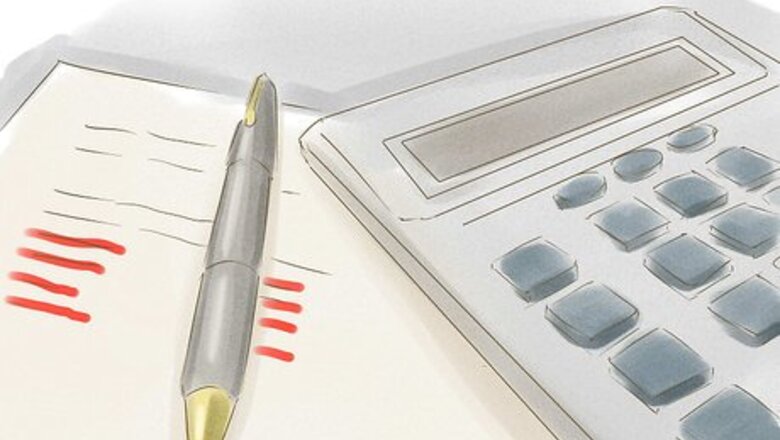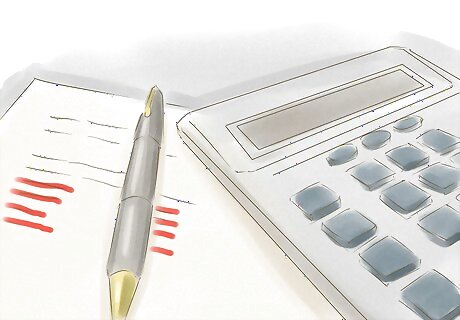
views
Calculating Asset Turnover

Locate net sales information for the period. Asset utilization can be calculated using any sales or revenue figure. However, the most commonly used number is net sales, which represent the total revenue collected over a period minus any discounts, returns, or allowances for damaged or missing products. This number is typically reported on a business's income statement as "net sales" or simply "sales." To find net sales, reduce gross sales by the total amount of all returns, discounts, and damaged or missing goods. Determine a period over which you want to measure asset utilization and record the net sales collected in that period. For example, a company might have $10,200,000 in sales for a given year. However, they lost $200,000 on returns, discounts, and damages, leaving them with $10,000,000 in net sales.

Calculate average total assets. Average total assets represents the total assets held by the business over the period in which asset utilization is being calculated. It can be calculated by adding the total assets at the beginning of the period plus the total assets at the end of the period and then dividing the total by two. Total assets includes all assets held by the business, including cash and cash equivalents, fixed assets, receivables, and others. Total assets should be stated on the business's balance sheets for each period. You can make a more specific analysis of asset utilization by only including assets directly used in production, such as plant equipment and property. For example, the company in the previous example might have assets of $7,500,000 at the beginning of the year and $8,500,000 at the end of that year. Their average total assets would then be the sum of the two ($16,000,000) divided by 2, which is $8,000,000.

Set up your equation. Asset utilization or, more specifically, asset turnover is calculated quite simply. The formula for asset utilization is Net Sales Average Total Assets {\displaystyle {\frac {\text{Net Sales}}{\text{Average Total Assets}}}} {\frac {{\text{Net Sales}}}{{\text{Average Total Assets}}}}. In other words, the formula calculates how many dollars of sales are created per dollar of assets held by the business. Place your data for net sales and average total assets into the equation to calculate asset turnover. For the company from the previous example, this would be $ 10 , 000 , 000 $ 8 , 000 , 000 {\displaystyle {\frac {\$10,000,000}{\$8,000,000}}} {\frac {\$10,000,000}{\$8,000,000}}

Divide to get asset utilization. Solve your equation by dividing net sales by average total assets. Your result will be a number, rather than a dollar amount. Continuing with the previous example, if a company had net sales of $10,000,000 and $8,000,000 in average assets, they would have an asset turnover of $ 10 , 000 , 000 ÷ $ 8 , 000 , 000 {\displaystyle \$10,000,000\div \$8,000,000} \$10,000,000\div \$8,000,000, or 1.25 {\displaystyle 1.25} 1.25.
Calculating Other Asset Utilization Ratios

Find your return on assets. Asset turnover is not the only way to calculate asset utilization. Another common measure of roughly the same performance metric is known as return on assets. This ratio compares net income, rather than sales, to total assets. Net income represents the company's profit (their "bottom line") over the period. Calculate return on assets using the following equation: Return on Assets = Net Income Average Total Assets {\displaystyle {\text{Return on Assets}}={\frac {\text{Net Income}}{\text{Average Total Assets}}}} {\text{Return on Assets}}={\frac {{\text{Net Income}}}{{\text{Average Total Assets}}}}.

Calculate accounts receivable turnover. Accounts receivable turnover is another financial ratio that measures how effective the business is at collecting money it is owed. Use the formula Accounts Receivable Turnover = Net Credit Sales Average Accounts Receivable {\displaystyle {\text{Accounts Receivable Turnover}}={\frac {\text{Net Credit Sales}}{\text{Average Accounts Receivable}}}} {\text{Accounts Receivable Turnover}}={\frac {{\text{Net Credit Sales}}}{{\text{Average Accounts Receivable}}}} to calculate this ratio. Net credit sales are all sales made on credit minus any returns, discounts, or allowances for damaged or lost goods.

Convert your result to the average collection period. After calculating accounts receivable turnover, you can easily find the average collection period. This represents how long, on average, an amount stays in the accounts receivable account before being collected. Calculate this ratio using the following formula: Average Collection Period = 365 Days Accounts Receivable Turnover {\displaystyle {\text{Average Collection Period}}={\frac {\text{365 Days}}{\text{Accounts Receivable Turnover}}}} {\text{Average Collection Period}}={\frac {{\text{365 Days}}}{{\text{Accounts Receivable Turnover}}}}. A long collection period may mean that the business is susceptible to cash flow shortages.

Determine inventory turnover. Another way to measure asset utilization is to look at how well a business manages its inventory. This can be done by calculating inventory turnover. Calculate this ratio using the following formula: Inventory Turnover = Cost of Goods Sold Average Inventory {\displaystyle {\text{Inventory Turnover}}={\frac {\text{Cost of Goods Sold}}{\text{Average Inventory}}}} {\text{Inventory Turnover}}={\frac {{\text{Cost of Goods Sold}}}{{\text{Average Inventory}}}}. Cost of goods sold can be found on a business's income statement. A small inventory turnover means that the company stores inventory for a longer period of time. This, in turn, increases storage costs and can mean lost sales opportunities.

Find the average age of inventory. Once you have inventory turnover, you can calculate the average age of an item in inventory using the following formula: Average Inventory Age = 365 Days Inventory Turnover {\displaystyle {\text{Average Inventory Age}}={\frac {\text{365 Days}}{\text{Inventory Turnover}}}} {\text{Average Inventory Age}}={\frac {{\text{365 Days}}}{{\text{Inventory Turnover}}}}. This is simply another way of looking at inventory turnover. Like all other ratios, this one can be compared to its historical values over time for the business or to the same ratio for a competing business.
Using Asset Utilization Ratios

Analyze your result. In general, asset utilization is a measure of how well a business is able to utilize their assets to produce revenue. A relatively high ratio means that the company is efficient in using their assets, whereas a low one may indicate poor asset management. How high a specific business's asset utilization ratio should be depends on its industry and stage in its lifecycle. From another angle, a low asset utilization ratio may indicate over-investment in assets.

Compare the result to that of competing companies. Asset turnover is most commonly used to compare the performance of one business or company to that of a competitor or the industry average. Because of operational differences, comparing asset turnover for businesses in different industries does not provide for an accurate comparison. Look for industry asset turnover averages in industry publications or use financial statements from a competing company to obtain figures that you can compare your asset turnover to. Asset turnover averages vary widely between industries. Whereas retail companies may have asset turnovers well over 2.00, financial and utilities companies may be close to 0.

Gauge efficiency over time. You can also compare the asset turnover of a business to its own historical asset turnover ratios. Ideally, a business should experience an increasing asset turnover ratio over time, due to either efforts to increase efficiency or economies of scale. Plot asset turnover over several different periods to assess whether or not asset turnover is increasing or decreasing for the business in question.

Use asset utilization as part of a broader analysis. While asset utilization can be useful in assessing business performance, it is not enough to make a complete assessment of the business. You need to combine asset utilization with other measures of performance and risk to determine how well the business is being managed. For example, you can combine asset utilization measures with profit margin and leverage ratios to get an overall idea of the business's performance.


















Comments
0 comment